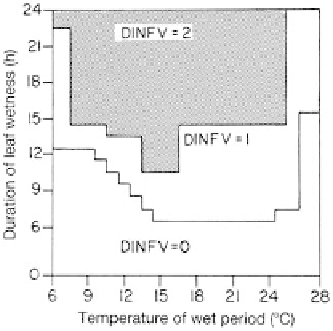Agriculture Reference
In-Depth Information
Fig. 5.14.
Chart for determining the daily infection values (DINFV) in the
BOTCAST model for forecasting the progress of leaf blight caused by
Botrytis
squamosa
on onions from temperatures and durations of periods of leaf wetness.
DINFV = 0, not conducive to infection; DINFV = 1, conducive to light infection;
DINFV = 2, conducive to severe infection (from Sutton
et al
., 1986. Courtesy of
Agriculture, Ecosystems and Environment
).
New York State, these showed 66% survival after burial 15 cm deep for 21
months (Ellerbrock and Lorbeer, 1977). After germinating, sclerotia give rise to
conidia, or sometimes ascospores, which disperse and infect leaves. Sclerotia
germinate between 5 and 25°C, fastest at 16°C, but produce the most conidia at
10°C. Germination rate and the number of conidia produced decline as soil water
potential decreases, although 60% sclerotial germination occurs in water
potentials as low as -2MPa (Clarkson
et al.
, 2000). Other pathogens perennate in
infected volunteer plants or bulbs, e.g. downy mildew, where infected onion sets
and mother bulbs for seed crops act as primary disease sources.
Disease control
Rational disease control rests on a detailed knowledge of the biology of the
pathogen and its interaction with the host crop. The life cycle of the pathogen
must be known, including how it perennates and spreads, so that primary
sources of infection can be identified and, if possible, eliminated. Knowledge of the
weather conditions favouring sporulation, infection and disease development
enables potential epidemics to be predicted, and preventive measures to be taken.
Crop hygiene is universally important in disease control. Potentially
infective crop residues and waste must be identified and destroyed. It is
important to avoid the spread of diseased debris on farm vehicles and equip-
ment and on the boots of workers. Volunteer plants appearing after a crop has


